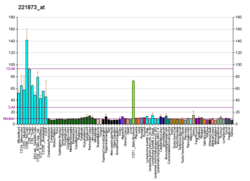Zinc finger protein 143 is a protein that in humans is encoded by the ZNF143 gene.[5]
References
edit- ^ a b c GRCh38: Ensembl release 89: ENSG00000166478 – Ensembl, May 2017
- ^ a b c GRCm38: Ensembl release 89: ENSMUSG00000061079 – Ensembl, May 2017
- ^ "Human PubMed Reference:". National Center for Biotechnology Information, U.S. National Library of Medicine.
- ^ "Mouse PubMed Reference:". National Center for Biotechnology Information, U.S. National Library of Medicine.
- ^ "Entrez Gene: ZNF143 zinc finger protein 143".
Further reading
edit- Tommerup N, Vissing H (1995). "Isolation and fine mapping of 16 novel human zinc finger-encoding cDNAs identify putative candidate genes for developmental and malignant disorders". Genomics. 27 (2): 259–64. doi:10.1006/geno.1995.1040. PMID 7557990.
- Schuster C, Myslinski E, Krol A, Carbon P (1995). "Staf, a novel zinc finger protein that activates the RNA polymerase III promoter of the selenocysteine tRNA gene". EMBO J. 14 (15): 3777–87. doi:10.1002/j.1460-2075.1995.tb00047.x. PMC 394452. PMID 7641696.
- Schaub M, Myslinski E, Schuster C, et al. (1997). "Staf, a promiscuous activator for enhanced transcription by RNA polymerases II and III". EMBO J. 16 (1): 173–81. doi:10.1093/emboj/16.1.173. PMC 1169624. PMID 9009278.
- Schuster C, Krol A, Carbon P (1998). "Two distinct domains in Staf to selectively activate small nuclear RNA-type and mRNA promoters". Mol. Cell. Biol. 18 (5): 2650–8. doi:10.1128/mcb.18.5.2650. PMC 110644. PMID 9566884.
- Myslinski E, Krol A, Carbon P (1998). "ZNF76 and ZNF143 are two human homologs of the transcriptional activator Staf". J. Biol. Chem. 273 (34): 21998–2006. doi:10.1074/jbc.273.34.21998. PMID 9705341.
- Rincon JC, Engler SK, Hargrove BW, Kunkel GR (1998). "Molecular cloning of a cDNA encoding human SPH-binding factor, a conserved protein that binds to the enhancer-like region of the U6 small nuclear RNA gene promoter". Nucleic Acids Res. 26 (21): 4846–52. doi:10.1093/nar/26.21.4846. PMC 147939. PMID 9776743.
- Mach CM, Hargrove BW, Kunkel GR (2002). "The Small RNA gene activator protein, SphI postoctamer homology-binding factor/selenocysteine tRNA gene transcription activating factor, stimulates transcription of the human interferon regulatory factor-3 gene". J. Biol. Chem. 277 (7): 4853–8. doi:10.1074/jbc.M108308200. PMID 11724783.
- Strausberg RL, Feingold EA, Grouse LH, et al. (2003). "Generation and initial analysis of more than 15,000 full-length human and mouse cDNA sequences". Proc. Natl. Acad. Sci. U.S.A. 99 (26): 16899–903. Bibcode:2002PNAS...9916899M. doi:10.1073/pnas.242603899. PMC 139241. PMID 12477932.
- Grossman CE, Qian Y, Banki K, Perl A (2004). "ZNF143 mediates basal and tissue-specific expression of human transaldolase". J. Biol. Chem. 279 (13): 12190–205. doi:10.1074/jbc.M307039200. PMID 14702349.
- Gerhard DS, Wagner L, Feingold EA, et al. (2004). "The status, quality, and expansion of the NIH full-length cDNA project: the Mammalian Gene Collection (MGC)". Genome Res. 14 (10B): 2121–7. doi:10.1101/gr.2596504. PMC 528928. PMID 15489334.
- Wakasugi T, Izumi H, Uchiumi T, et al. (2007). "ZNF143 interacts with p73 and is involved in cisplatin resistance through the transcriptional regulation of DNA repair genes". Oncogene. 26 (36): 5194–203. doi:10.1038/sj.onc.1210326. PMID 17297437. S2CID 21482216.
- Myslinski E, Gérard MA, Krol A, Carbon P (2007). "Transcription of the human cell cycle regulated BUB1B gene requires hStaf/ZNF143". Nucleic Acids Res. 35 (10): 3453–64. doi:10.1093/nar/gkm239. PMC 1904299. PMID 17478512.
- Gérard MA, Krol A, Carbon P (2007). "Transcription factor hStaf/ZNF143 is required for expression of the human TFAM gene". Gene. 401 (1–2): 145–53. doi:10.1016/j.gene.2007.07.011. PMID 17707600.
- Yuan CC, Zhao X, Florens L, et al. (2007). "CHD8 associates with human Staf and contributes to efficient U6 RNA polymerase III transcription". Mol. Cell. Biol. 27 (24): 8729–38. doi:10.1128/MCB.00846-07. PMC 2169411. PMID 17938208.
External links
edit- ZNF143+protein,+human at the U.S. National Library of Medicine Medical Subject Headings (MeSH)
- FactorBook Znf143
This article incorporates text from the United States National Library of Medicine, which is in the public domain.




